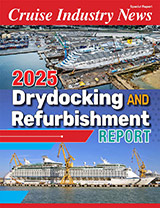Athens: “A shift from traditional fuels to natural gas is necessary if the shipping industry is to meet expectations of substantial reductions in CO2 emissions,” said COO Tor Svensen as DNV presented elements of a road map for how the shipping industry can reduce its CO2 emissions. “Only a common effort of the industry can keep regulators from imposing damaging new requirements on shipping to achieve environmental improvements,” he said.
“The shipping industry needs to establish ambitious targets for its CO2 emissions,” Tor Svensen said at a press conference in Posidonia. “Shipping will face tough expectations of emission reductions, in line with all other industries. At DNV, we believe that CO2 emissions can be reduced by as much as 30–50% by actions taken on existing vessels and for newbuildings prior to 2030.”
The main elements of such reductions would be operational improvements, including weather routing, the optimisation of energy consumption and close cooperation between charterers and owners. Logistic improvements to vessels and ports and, not least, speed optimisation can also contribute to emission reductions. The same is true for improvements to engines, propellers, hulls and coatings.
Towards 2050, emissions can be reduced by as much as 50–70% provided there is a real commitment by all the major players in the industry. “The introduction of non-carbon-based fuel is likely to be the crucial factor determining whether shipping ultimately manages to substantially reduce its CO2 emissions,” said Mr Svensen.
Replacing carbon-based fuel with other sources of energy requires investments in R&D now, including in wave and wind power, solar panels, sustainable biofuels, fuel cells and nuclear energy. Radically new technologies, not known today, will play an important part in reaching the target of 50–70% emission reductions by 2050.
Mr Svensen emphasised that shipping is the most energy efficient means of transportation. “Shipping is part of the solution. By moving more cargo from air or trucks and even rail to ships, the overall emissions will be reduced,” he said.
“We are now introducing elements of a roadmap and invite the other major stakeholders in the entire shipping industry to take part in developing this. Elements of the roadmap introduced by DNV are:
* A concerted effort by all key stakeholders in the industry
* A real commitment to defined actions both on existing vessels and for newbuildings, including contributions from technology, operations and new fuels
* Support for a global regulatory regime based on the IMO, not regional schemes
* Intensified research into alternative energy sources
* Agreement on an ambitious time schedule
“Shipping cannot reach ambitious emission reduction targets without a committed collaboration between ship operators, cargo owners and port operators,” says Tor Svensen. “Speed limits are preferred as a good alternative for achieving a real reduction in the CO2 emissions of existing vessels compared to CO2 trading or a CO2 tax on fuel.”
For new designs, DNV advocates a technical CO2 design index introduced for major ship types, with gradually tightening emission limits and the gradual implementation of specific emission limits for Marine Propulsion Plants.
Date: 2008-06-04



